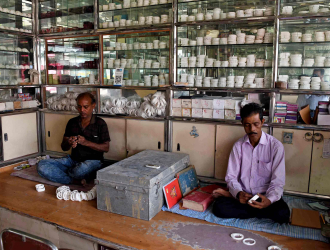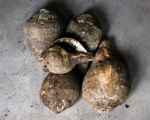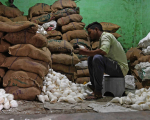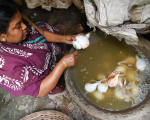Sixty-one-year-old Shibu Nandi knows it’s the end of the road. Neither his daughter nor his nephew wants to continue the family business of selling conches (sankha) and conch products. In a way, Shibu and his brother are happy that their children have moved away from their ancestral occupation. ‘Women from upper caste families used to bow down and touch our feet after we fit bangles on their wrists, but who cares now? Nobody wants to use conch bangles in modern times. When they do buy these products, they want bigger sizes so they can be worn only on special occasions and removed easily. These bangles hardly break and last a lifetime, hence there is little need to buy replacements. And, frankly, how can we meet demand without a supply of conch shells?’ laments Shibu Nandi. Facing mounting pressure from cheaper machine-made plastic bangles and the falling quality of raw conches, Nandi is disillusioned about the future of the trade.
Raw conch shells are produced by a species of sea snails, Turbinella pyrum, which are found in the Gulf of Mannar and the Indian Ocean coastline. Rameswaram, Tuticorin and Tirunelveli in Tamil Nadu are three districts which supply the bulk of raw conches. The conch pickers and suppliers are mostly Muslims. A community of Tamil Muslims live in Barrackpore, in the suburbs of Kolkata, and they act as the principal suppliers of raw conches to workshops in North 24 Parganas district. Ali, a 37-year old Tamil trader, echoes Shibu Nandi when he says he is worried about the declining quality and rising costs of collecting conches from the sea. He blames pollution of the oceans, overfishing and global climate change as causes for the decline.
However, climate change is just one of the many factors affecting the trade. ‘A big blow to the trade came in 2001, when a ban was imposed by Maneka Gandhi under the Indian Wildlife Protection Act. This was followed by the 2004 tsunami,’ says Tarak Nath Dutta, one of the biggest bangle producers in the Bag Bazar neighbourhood in North Kolkata. The Boxing Day Tsunami did extensive damage to the Indian coastline and changed the marine ecosystem of the Gulf of Mannar. The molluscs inhabit waters having a delicate balance of right temperature, salinity levels and depth of the sea floor, all of which were disturbed by the tsunami. In the aftermath, harvesting of Turbinella pyrum declined, and the cost of raw conches increased.
The value of conch depends on its white colour—a symbol of purity. The white conch has wide representation in Indian art and iconography. The Panchajanya sankha is associated with Lord Vishnu. Along with Vishnu’s chakra (Sudarshana), the Panchajanya are depicted outside Vishnu temples across India. The sankha is also held by various avatars of Vishnu, like Matsya, Kurma, Varaha and Vamana (universally), and other important Hindu deities like Lakshmi, Surya, Indra, Kartikeya and Durga (with regional variations). The sankha is also associated with Gautama Buddha, hence held sacred in Buddhism. The right-turning white conchis one of the Ashtamangalas, the eight auspicious symbols (also sacred in Hinduism and Jainism) in Tibetan Buddhism. In Buddhism, the conch’s piercing sound is perceived to remove ignorance and awaken the inner consciousness from slumber. In Jainism, the conch is the symbol of Neminatha, the twenty-second Tirthankara. Till the state merged with India in 1949, the erstwhile Kingdom of Travancore (in modern Kerala) had the sankha represented on their official flag.
On the discovery of Harappan sites from the 1920s, archaeologists found ample evidence of conch shell craft in the Indus Valley Civilisation. The smooth, shiny surface of conches gives them a porcelain-like quality, and the hard material is ideal for carving. The conches used in religious rituals only involve drilling a small hole through the apex. These conches can then be blown like a trumpet producing a deep, sonorous sound (sankhanaad). Sankhanaad symbolises the Om sound, sacred in Hinduism and Buddhism. In ancient times, the blowing of conches announced the commencement of wars. During the Mahabharata War, all five Pandava brothers are described having their own shankhas, with individual names. Though conches are no longer used in battle, they are still blown during important Hindu religious rituals, and a smaller conch (Jala sankha) is used to store/pour holy water.
Conch traders are known as Sankhabanik and the craftsmen are known as Sankhari. Sankharis either work directly on the intact conch surface or cut multiple bangles from a single conch. The bangles are then polished and engraved, and the finished bangles are worn predominantly by Hindu Bengali women, hence the craft thrived in Bengal, Assam and Odisha. In Bengali culture, sankha bangles are gifted to a bride on her wedding day as a symbol of marriage, and she is expected to wear them throughout her married life, discarding them only after the demise of her husband. This custom derives from an ancient association of the conch with fertility, because of the distinct shape of the conch that resembles a female vulva.
The struggle for survival of the Sankhari community is in stark contrast to the popularity of the craft in the past. Famous English zoologist and ethnographer James Hornell (1865-1949) did extensive research on marine organisms and indigenous watercrafts in Southern India and Sri Lanka. He came to the conclusion that conch craft existed in Tamil Nadu from the first century CE and artisans from Southern India settled in Dhaka during the fourteenth century (or probably earlier). Since then, the epicentre of the Sankhari community in undivided Bengal was in Dhaka, in the old Sankhari Bazaar.
In 1947, Dhaka, and other hubs at Rangpur, Faridpur, Pabna and Chittagaon, became part of East Pakistan (modern Bangladesh). The Sankhari communities which arrived as refugees in newly created West Bengal were settled in Kolkata. In 1953, the refugee rehabilitation department tried to create a Sankhari Colony at Ashok Nagar, in Habra, for around 300 families who were living in the slums of Raja Bazar and Bag Bazar areas. They were offered 6 katah of land and 2000 rupees compensation for each family, but the programme failed because people refused to resettle. In 1956, the refugee rehabilitation department tried to establish a colony again, this time in Barrackpore, a suburb around 20 kilometres from Kolkata. This time they were successful and, together with the artisans, the traders and wholesalers also settled here. Since then, Barrackpore has developed as a hub of conch craft. One can easily find numerous conch traders and shops selling conch products along Ghoshpara Road.
Unfortunately, unlike in Barrackpore, the craft has steadily declined in Kolkata. Even a few decades ago, there used to be pockets in Bhawanipur, College Street, Keshab Chandra Street and Dumdum, where the Sankhari community lived in large numbers. Now, many old Sankhari settlements are completely extinct. ‘Earlier, traders used to request me to work for them at a premium price, especially during festivals, but now it is difficult to find employment for more than 15 days in a month,’ says Bankim Samanta, who has been in this trade from the age of 15. Now in his early sixties, he looks like a malnourished and emaciated man. ‘Who bothers to wear old-fashioned bangles?’ asks Samanta.
In a bid to survive, traders and craftsmen are diversifying their product range by making rings, hair clips, brooches, earrings, necklaces, pendants, paperweights, small boxes, agarbatti stands, buttons, vermillion containers, spoons, forks, etc. Even so, low-level workers like Snehangshu Sen, an artisan from Shankha Nagar Colony, Barrackpore, are struggling. He cannot afford therapy for his autistic son. ‘I know the future will be tough. There is no government scheme to support us, unlike other art forms such as dokra or chhau mask making. There is no pension. I will pass my skills to my wife so that she can run the show after if I die.’ In a bid to survive, conch bangles are combined with intricate gold filigree work, and these fetch a higher price. However, these changes may only sustain the industry in the short term and the Sankhari community is currently looking at an uncertain future.
Shibu Nandi reflects on the current crisis, ‘In 1978, the chief minister of West Bengal, Jyoti Basu, talked with M.G Ramachandran, the then chief minister of Tamil Nadu, and made a policy which enabled easy import of conch shells; he also awarded a tax waiver to the craftsmen in Bengal. These things helped a lot in the initial days but then competition in the open market and increasing foul play by the syndicates jacked up prices of raw conches. Now the state has no intention to help us.’ Ramkrishna Sen, a young trader in Bag Bazar, feels the West Bengal government should promote and market their products. ‘The marketing of finished products, through Manjusha in 1976 by the West Bengal Handicrafts Development Corporation and through Bangashree in 1973 by the West Bengal State Handicrafts Co-operative Society Ltd., was a blessing for our community. We have skilled artisans. The state needs to ensure the supply of raw materials at a fair price. And there should be some schemes to support healthcare and pension for senior craftsmen,’ he says. The government must come up with a comprehensive scheme for marketing and market development, ensuring steady supply of raw material and proper healthcare and pension facilities that can save the life of the conch craftsmen and enable them to continue this ancient craft which is an integral part of both Hindu and Buddhist populations in Bengal.

















